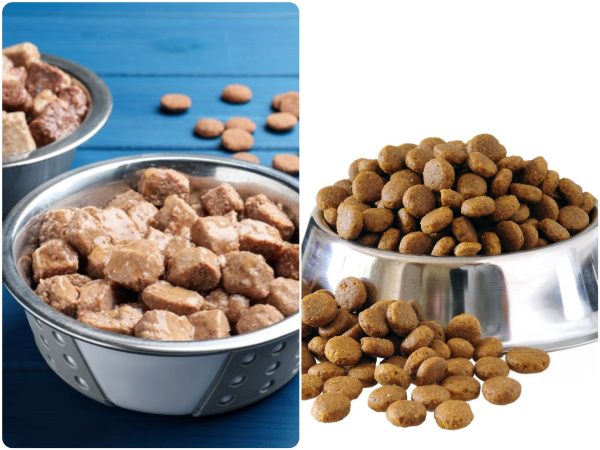When you bring a new puppy home, every decision you make can have a lasting impact—especially when it comes to their nutrition. Puppy food is more than just fuel; it’s the foundation for strong bones, brain development, immune resilience, and even behavior. One of the first major choices pet parents face is: “Should I feed my puppy dry kibble, wet canned food, or a combination of both?“
As a veterinarian with over 15 years of experience working with puppies of all breeds—from tiny Chihuahuas to massive Great Danes—I can tell you: there’s no universal answer. However, by understanding the unique pros and cons of both dry and wet puppy food, you can make the best choice for your growing pup’s needs, lifestyle, and health goals.
In this comprehensive guide, we’ll dive into the nutritional needs of puppies, break down the advantages and disadvantages of each type of food, and help you make an informed decision.

1. Nutritional Needs of a Growing Puppy
Before choosing between dry or wet food, it’s essential to understand what your puppy’s body actually requires to thrive.
Growing puppies have higher nutritional demands compared to adult dogs. Their diets must provide:
- Higher Calories: To fuel rapid growth, boundless energy, and brain activity
- Elevated Protein Levels: For muscle, tissue, and organ development
- Calcium and Phosphorus: To build strong bones and joints
- DHA (Docosahexaenoic Acid): An omega-3 fatty acid critical for brain and vision development
- Antioxidants: For immune system strength
- Healthy Fats: To support skin and coat health
Key Point:
No matter which type of food you choose, it must be labeled “Complete and Balanced for Growth” according to AAFCO standards to ensure your puppy gets all essential nutrients.
2. Dry Puppy Food: Benefits and Considerations
Dry puppy food, commonly known as kibble, is the most popular choice among pet owners—and for good reasons.
Pros of Dry Puppy Food:
- Affordability: Dry food is typically more cost-effective on a per-meal basis.
- Long Shelf Life: Resealable bags stay fresh for weeks when stored properly.
- Dental Health: Crunching kibble helps scrape plaque off teeth, promoting better dental hygiene.
- Convenience: Easy to measure, store, and feed—ideal for busy households.
- Great for Training: Kibble pieces double as low-calorie rewards for obedience and trick training.
- Good for Multi-Dog Households: Easier to manage when feeding multiple pups.
Cons of Dry Puppy Food:
- Lower Moisture Content: Puppies who don’t drink enough water might become mildly dehydrated.
- Less Palatable: Picky eaters may not find kibble as tempting as wet food.
- Not Ideal for Dental Issues: Puppies with sensitive gums or missing teeth (due to teething) may struggle to chew hard kibble.
Pro Tip:
For teething puppies, you can soften dry kibble by soaking it briefly in warm water or puppy-safe broth to make it easier to chew.
3. Wet Puppy Food: Benefits and Drawbacks
Wet puppy food comes in cans, trays, or pouches and is often more palatable and digestible than dry kibble, especially for young puppies adjusting to solid food.
Pros of Wet Puppy Food:
- Higher Moisture Content: Excellent for hydration support, especially in hot climates or less water-drinking puppies.
- Soft and Easy to Chew: Perfect for teething puppies, dogs recovering from surgery, or those with small mouths.
- Strong Aroma and Flavor: Appeals to picky eaters and stimulates appetite.
- Gentler on the Stomach: Wet food can be easier to digest and cause fewer tummy troubles.
- Supports Weight Gain: Helpful for underweight or frail puppies needing extra calories.
Cons of Wet Puppy Food:
- More Expensive: Cost per meal is significantly higher compared to kibble.
- Storage Requirements: Must be refrigerated after opening and used within a few days.
- Messier Feeding Experience: Can be trickier to portion and clean up.
- Dental Health Concern: Does not naturally help clean teeth—requires added dental hygiene measures.
Ideal for:
Toy breeds, sensitive stomachs, underweight puppies, and dogs recovering from illness or surgery.
4. Comparison Chart: Dry vs Wet Puppy Food
Here’s a quick side-by-side look at how dry and wet foods stack up for your puppy:
| Aspect | Dry Food (Kibble) | Wet Food (Canned/Pouch) |
| Moisture Content | 10–12% | 70–80% |
| Caloric Density | High (more calories per cup) | Lower (requires more volume to meet caloric needs) |
| Shelf Life (Opened) | Up to 6 weeks (sealed bag) | 2–3 days (refrigerated) |
| Dental Benefits | Helps reduce tartar and plaque buildup | None—may contribute to dental plaque |
| Ease of Feeding | Easy, neat, and convenient | May require cleanup and refrigeration |
| Monthly Cost (Medium Puppy) | $40–$60 | $90–$140 |
| Palatability | Moderate | Very high—great for picky eaters |
Summary:
While dry food excels in affordability, dental health, and convenience, wet food scores high for palatability, hydration, and ease of digestion—especially in young, sensitive, or teething pups. Understanding your puppy’s specific needs will help guide whether a dry, wet, or mixed diet is ideal.
5. Top Vet-Recommended Puppy Foods in Each Category (2025)
After years of clinical experience and reviewing updated veterinary nutrition studies, here are my top puppy food picks for 2025 in both dry and wet categories:
| Brand | Type | Key Protein | Best For | Price (USD) |
| Hill’s Science Diet Puppy | Dry | Chicken | Overall balanced growth across breeds | $52 (15 lb bag) |
| Royal Canin Puppy Formula | Dry | Chicken/By-Products | Breed-specific needs and small bite sizes | $55 (17 lb bag) |
| Blue Buffalo Homestyle Puppy | Wet | Chicken | Grain-free, highly palatable option for picky eaters | $39 (12 cans) |
| Purina Pro Plan Puppy Wet | Wet | Turkey/Chicken | Sensitive stomachs, underweight pups needing extra calories | $42 (12 cans) |
| Wellness CORE Puppy | Dry | Turkey & Chicken | High-protein, grain-free choice for active puppies | $58 (12 lb bag) |
Additional Brand Insights:
- Hill’s Science Diet Puppy is ideal for those seeking a well-researched and balanced formula backed by years of clinical testing. It contains DHA from fish oil and antioxidants to boost immune development.
- Royal Canin Puppy Formula offers specialized kibble shapes tailored to breed-specific jaw structures, making chewing and digestion more effective.
- Blue Buffalo Homestyle Wet is crafted with real meat and no by-products, making it a go-to option for picky eaters or puppies with sensitivities.
- Purina Pro Plan Puppy Wet delivers excellent digestibility and is rich in nutrients like DHA and omega-6, making it suitable for puppies who need additional support.
- Wellness CORE Puppy Dry is formulated with premium proteins and fortified with superfoods, ideal for energetic puppies with high metabolism needs.
Important Note:
Always choose foods that clearly state “complete and balanced for growth” according to AAFCO—this ensures your puppy gets full nutrition during the critical development phase.
6. Feeding Guidelines: Wet, Dry, or a Mix?
How you feed your puppy matters just as much as what you feed them. Different feeding strategies suit different needs.
If your puppy has a healthy appetite and no specific health issues, feeding them dry food only is convenient, cost-effective, and supports dental health. For puppies who are teething, recovering from illness, or are picky eaters, wet food might be more appealing and digestible. A mixed feeding approach allows you to harness the best of both worlds: feed dry kibble in the morning to promote chewing and dental health, then offer wet food in the evening for hydration and taste. You can also use softened kibble or wet food as training rewards throughout the day.
Tip:
Be sure to calculate total calories when combining food types to avoid overfeeding. Always check the feeding guide on the label and consult your vet for personalized advice.
Summary:
Whether you choose dry, wet, or a combination, your puppy’s mealtime should support both their health and lifestyle. Mixed feeding is especially beneficial for households balancing budget, dental care, and taste preferences.
7. FAQs: Dry vs Wet Puppy Food
Let’s clear up some of the most common concerns pet parents have when making this important choice:
Q: Is dry food more nutritious than wet food?
A:
No. Both can be highly nutritious if labeled “complete and balanced.” It’s about the formula and ingredients, not just the format.
Q: Can I feed my puppy only wet food?
A:
Yes—provided the wet food is labeled for “growth” stages and is complete and balanced.
However, you’ll need to monitor dental hygiene more closely by brushing teeth or providing dental chews.
Q: Can I switch between dry and wet food?
A:
Yes, but always transition gradually over 7–10 days to avoid digestive upset.
Start by mixing a small amount of the new food into the old and increase it slowly each day.
Q: Which is better for teething puppies?
A:
Wet food is often gentler for teething pups.
You can also soak kibble in warm water to soften it without switching entirely to wet food.
Q: How can I improve my puppy’s digestion overall?
A:
- Choose limited-ingredient diets with highly digestible proteins.
- Avoid foods heavy in artificial additives and fillers.
- Incorporate vet-approved probiotics if needed to support gut flora.
8. Cost Comparison: Monthly Estimate for a Medium Puppy
Here’s a quick look at what you can expect to spend monthly based on your chosen feeding strategy:
| Food Type | Daily Intake (Medium Puppy) | Monthly Cost (Approximate) |
| Dry Food Only | ~2 cups per day | $45–$60 |
| Wet Food Only | ~1.5 cans per day | $95–$130 |
| Combo Feeding | 1 cup dry + 1 can wet per day | $75–$100 |
Expanded Cost Overview:
Dry food offers a longer shelf life and stretches your dollar, making it the most budget-conscious option for puppy parents. Wet food, while flavorful and nutritious, can quickly add up in cost—especially for medium to large breeds. Combo feeding delivers a middle ground that many pet owners prefer: a satisfying feeding routine that incorporates both affordability and flavor variety.
Money-Saving Tip:
Use wet food as a topper rather than the main meal. Mixing a small amount of wet food with dry kibble boosts appetite and taste without significantly increasing monthly expenses.
Final Summary
Feeding your puppy is one of the most impactful decisions you’ll make during their formative months. Both dry and wet food offer unique benefits: dry food supports dental health and is cost-effective, while wet food aids hydration and encourages appetite.
Vet-recommended options in each category cater to different needs, from sensitive digestion to high-protein energy requirements. Mixed feeding often provides the best of both worlds—nutritionally and financially.
By understanding your puppy’s specific needs, you can confidently choose a feeding plan that supports healthy growth, vibrant energy, and lifelong well-being.


